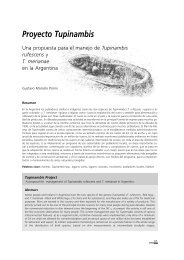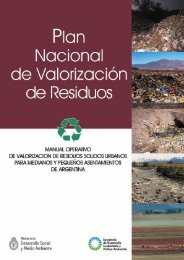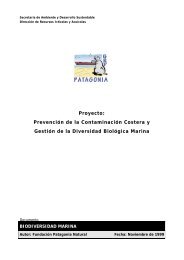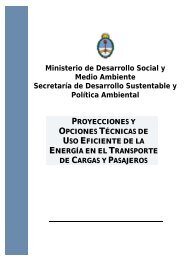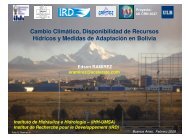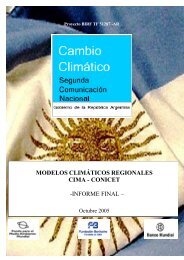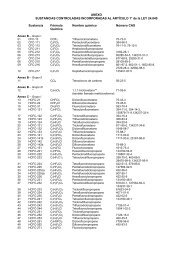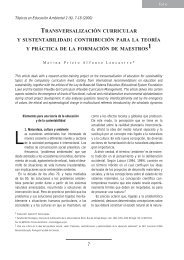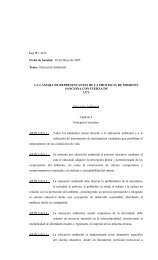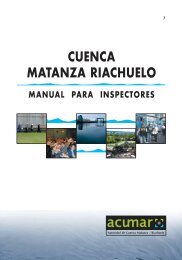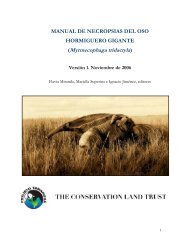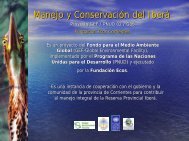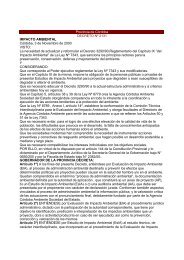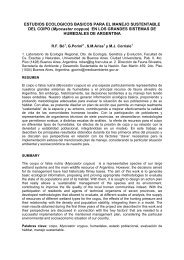Coypu Project - Secretaria de Ambiente y Desarrollo Sustentable
Coypu Project - Secretaria de Ambiente y Desarrollo Sustentable
Coypu Project - Secretaria de Ambiente y Desarrollo Sustentable
You also want an ePaper? Increase the reach of your titles
YUMPU automatically turns print PDFs into web optimized ePapers that Google loves.
Management of wild life in ArgentinaIntroductionThe species and its useThe coypu (Myocastor coypus), also calledquiyá or false otter, is a relatively large ro<strong>de</strong>nt(it weights an average of 5 kg), of amphibioushabits, native of large wetland systemscharacteristic of southeastern regions inSouth America (Parera, 2002). This species isone of the most representative and historicallyabundant species of wild fauna in Argentina(Bó et al., in press) due to its herbivorousnature, its relatively high reproductive rate, itstolerance to a wi<strong>de</strong> range of climatic andhydrologic conditions and its high capacity ofdispersion and colonization. This isparticularly true for the subspecies M.c.bonariensis, which inhabits the basins of ourregional large rivers (Paraguay, Paraná,Uruguay and Río <strong>de</strong> la Plata) and the lakesystems of the pampas.The interaction between man and coypu isvery old. Guaraníes, chaná-timbués andquerandíes, among others, used coypus’meat as food and its skin to make clothing.Later, the criollos intensified their use not onlywith the purpose of human survival, but alsoencouraged by the commercial <strong>de</strong>mand ofskins. The sale of coypu skin has been and ispresently very important for our country. Forexample, until 1997, an average of 5,000,000skins were exported annually (Bó, 1999). Forseveral <strong>de</strong>ca<strong>de</strong>s, the number of specimenscaptured, the important quantity of peopleinvolved in the different links of thecommercial circuit (such as hunters,gatherers, tanners, furriers and exporters) andthe amount of money in circulation have ma<strong>de</strong>the coypu the main resource of wild fauna inArgentina (Bertonatti and Corcuera, 2000).However, until very recently, scientificresearches on the coypu in its original andnatural environment were scarce and isolated.What is more, until 1998, hunting activitieswere carried out without a specimen’s quota,ad<strong>de</strong>d to the fact that the official huntingseason (fall-winter) was set according toclearly commercial criteria and not accordingto ecological ones. As fall-winter is the col<strong>de</strong>stseason of the year, the felt of the coypus’ skinis thicker and has, therefore, greater value(Porini et al., 2002b).Objectives of the projectThe need to advance knowledge on thebioecological aspects of the coypus and tosubsequently propose accurate gui<strong>de</strong>lines forits management led professionals andtechnicians from the DFS (State Departmentof Wild Fauna), the provincial <strong>de</strong>partments offauna from Buenos Aires, Entre Ríos, SantaFé, Corrientes and, most recently, Chaco andFormosa (Santiago <strong>de</strong>l Estero, Cordoba andRío Negro will soon be incorporated), andresearchers from the University of BuenosAires Faculty of Exact and Natural Sciences(FCEYN-UBA) to start in 2001 the <strong>Coypu</strong><strong>Project</strong> (Bó and Porini, 2001). In this paper,the activities and advances of the first threeyears of the project are summarized. Themain objectives of this first phase were:• To generate basic bioecologicalinformation on M. coypus.• To <strong>de</strong>sign and test methodologies forthe a<strong>de</strong>quate gathering of suchinformation.• To evaluate the conditions of wildpopulations and their habitat in the main“coypus exploitation areas” in Argentina.• To formulate recommendations for thesustainable management of thespecies.On the basis of the data collected, a plan ofaction has been initiated through simple andconcrete measures. This plan aims atcontributing not only to the sustainablemanagement of the species and of thewetlands it inhabits, but also to theimprovement on the quality of life of thosehuman communities in our country that havetraditionally used the coypu as a resource fortheir survival. This project is expected tocontribute in the taking of administrative<strong>de</strong>cisions on the coypu resource witha<strong>de</strong>quate scientific grounds and precise tools–realistic as regards their effectivepossibilities of implementation. It is alsoexpected to allow collecting information atlevels fitting the <strong>de</strong>cisions of both users andgovernmental officials.- 2 -



